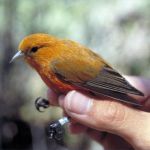NATIVE SPECIES

Prioritization planning for coastal wetland restoration on Molokaʻi
PI: Judith Drexler, Research Hydrologist, USGS California Water Science Center
Co-Is: James Jacobi, Biologist, USGS Pacific Island Ecosystems Research Center; Curt Storlazzi, Research Geologist, USGS Pacific Coastal and Marine Science Center
Funded: FY2021
Co-Is: James Jacobi, Biologist, USGS Pacific Island Ecosystems Research Center; Curt Storlazzi, Research Geologist, USGS Pacific Coastal and Marine Science Center
Funded: FY2021

Responses to transplanting corals to enhance reef resilience
PI: Crawford Drury, Affiliate Researcher, Hawaiʻi Institute of Marine Biology, UH Mānoa
Funded: FY2021
Funded: FY2021

2021 SURF Projects
Six students completed projects in climate adaptation science for the 2021 SURF program, investigating stream flow quality and variability, coastal erosion, fish thermal tolerance, fishpond phytoplankton distribution, and reef microplastics.

Predicting and mitigating avian disease at Hakalau Forest National Wildlife Refuge
PI: Dennis LaPointe, Research Ecologist, USGS Pacific Island Ecosystems Research Center
Funded: FY2021
Funded: FY2021

Mangrove vulnerability to sea-level rise factsheet
Mangrove forests and the benefits they provide to Micronesian ecosystems and communities are threatened by accelerating sea-level rise and human activities. Read this factsheet to learn more.

Effect of extreme tidal events on future sea-level rise scenarios for He‘eia fish communities
PI: Yoshimi Rii, Research Coordinator, He'eia NERR/HIMB, UH Mānoa
Co-Is: Rob Toonen, Research Professor, HIMB, UH Mānoa; Kawika Winter, Reserve Manager, Heʻeia NERR/HIMB, UH Mānoa
Funded: FY2021
Co-Is: Rob Toonen, Research Professor, HIMB, UH Mānoa; Kawika Winter, Reserve Manager, Heʻeia NERR/HIMB, UH Mānoa
Funded: FY2021

Vulnerability of coastal ecosystems to increased salinity from climate change
PI: Kasey Barton, Associate Professor of Botany, UH Mānoa
Co-PI: Anna McCormick, Department of Botany, UH Mānoa
Funded: FY2020
Co-PI: Anna McCormick, Department of Botany, UH Mānoa
Funded: FY2020

US Fish & Wildlife Service ‘opihi project podcast
A fifteen minute podcast hosted by the US Fish & Wildlife Service highlighting MCC graduate student Lauren Kapono and her work monitoring 'opihi (Cellana spp.) along the Kalaemanō shoreline of Hawaiʻi Island.

Projected species range maps over the next century
These maps address how climate change may shift plant distributions, particularly native endangered plants, within the Hawaiʻi Volcanoes National Park to help inform management of Special Ecological Areas.

Climate Change Atlas: Dominant vegetation in the Hawaiian Islands
With changing climate possibly shifting the location and scale of suitable habitat for native Hawaiian plants, managers need concrete information, like these maps, on where likely best future habitats will exist to inform conservation decision making.

